stop start HUMMER H3 2009 Owner's Manual
[x] Cancel search | Manufacturer: HUMMER, Model Year: 2009, Model line: H3, Model: HUMMER H3 2009Pages: 382, PDF Size: 1.99 MB
Page 187 of 382
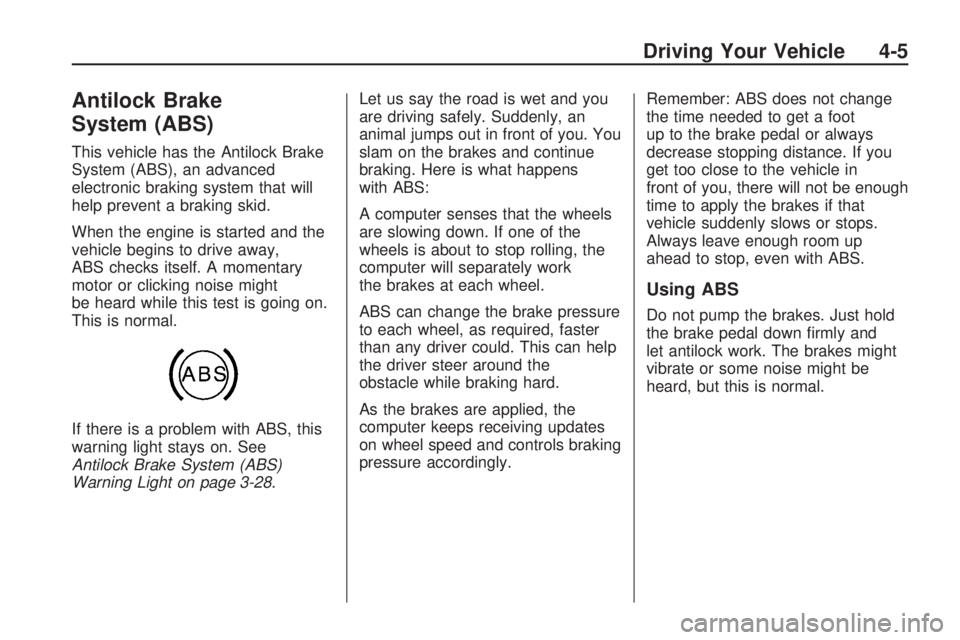
Antilock Brake
System (ABS)
This vehicle has the Antilock Brake
System (ABS), an advanced
electronic braking system that will
help prevent a braking skid.
When the engine is started and the
vehicle begins to drive away,
ABS checks itself. A momentary
motor or clicking noise might
be heard while this test is going on.
This is normal.
If there is a problem with ABS, this
warning light stays on. See
Antilock Brake System (ABS)
Warning Light on page 3-28.Let us say the road is wet and you
are driving safely. Suddenly, an
animal jumps out in front of you. You
slam on the brakes and continue
braking. Here is what happens
with ABS:
A computer senses that the wheels
are slowing down. If one of the
wheels is about to stop rolling, the
computer will separately work
the brakes at each wheel.
ABS can change the brake pressure
to each wheel, as required, faster
than any driver could. This can help
the driver steer around the
obstacle while braking hard.
As the brakes are applied, the
computer keeps receiving updates
on wheel speed and controls braking
pressure accordingly.Remember: ABS does not change
the time needed to get a foot
up to the brake pedal or always
decrease stopping distance. If you
get too close to the vehicle in
front of you, there will not be enough
time to apply the brakes if that
vehicle suddenly slows or stops.
Always leave enough room up
ahead to stop, even with ABS.
Using ABS
Do not pump the brakes. Just hold
the brake pedal down �rmly and
let antilock work. The brakes might
vibrate or some noise might be
heard, but this is normal.
Driving Your Vehicle 4-5
Page 188 of 382
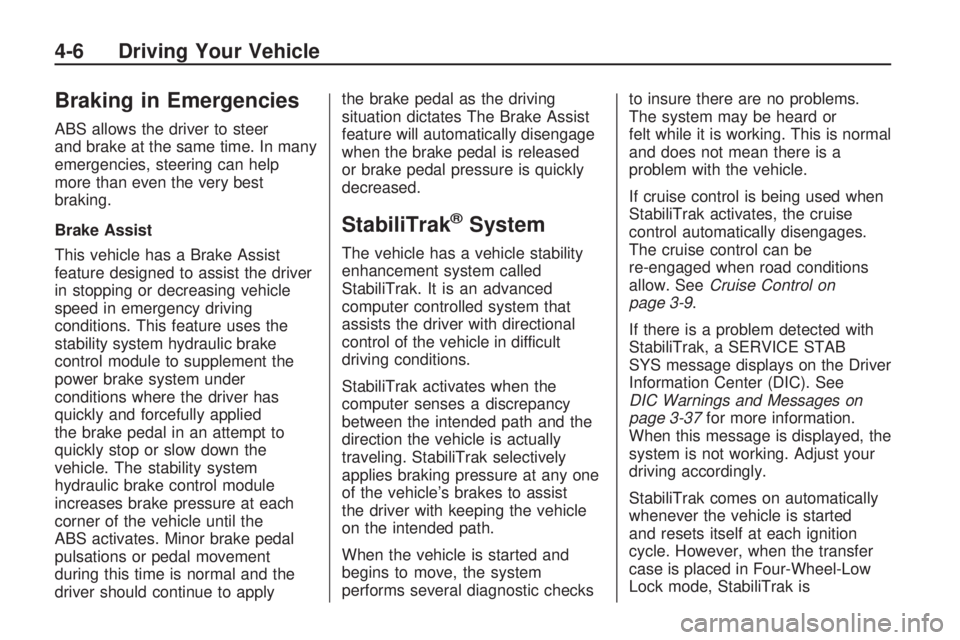
Braking in Emergencies
ABS allows the driver to steer
and brake at the same time. In many
emergencies, steering can help
more than even the very best
braking.
Brake Assist
This vehicle has a Brake Assist
feature designed to assist the driver
in stopping or decreasing vehicle
speed in emergency driving
conditions. This feature uses the
stability system hydraulic brake
control module to supplement the
power brake system under
conditions where the driver has
quickly and forcefully applied
the brake pedal in an attempt to
quickly stop or slow down the
vehicle. The stability system
hydraulic brake control module
increases brake pressure at each
corner of the vehicle until the
ABS activates. Minor brake pedal
pulsations or pedal movement
during this time is normal and the
driver should continue to applythe brake pedal as the driving
situation dictates The Brake Assist
feature will automatically disengage
when the brake pedal is released
or brake pedal pressure is quickly
decreased.
StabiliTrak®System
The vehicle has a vehicle stability
enhancement system called
StabiliTrak. It is an advanced
computer controlled system that
assists the driver with directional
control of the vehicle in difficult
driving conditions.
StabiliTrak activates when the
computer senses a discrepancy
between the intended path and the
direction the vehicle is actually
traveling. StabiliTrak selectively
applies braking pressure at any one
of the vehicle’s brakes to assist
the driver with keeping the vehicle
on the intended path.
When the vehicle is started and
begins to move, the system
performs several diagnostic checksto insure there are no problems.
The system may be heard or
felt while it is working. This is normal
and does not mean there is a
problem with the vehicle.
If cruise control is being used when
StabiliTrak activates, the cruise
control automatically disengages.
The cruise control can be
re-engaged when road conditions
allow. SeeCruise Control on
page 3-9.
If there is a problem detected with
StabiliTrak, a SERVICE STAB
SYS message displays on the Driver
Information Center (DIC). See
DIC Warnings and Messages on
page 3-37for more information.
When this message is displayed, the
system is not working. Adjust your
driving accordingly.
StabiliTrak comes on automatically
whenever the vehicle is started
and resets itself at each ignition
cycle. However, when the transfer
case is placed in Four-Wheel-Low
Lock mode, StabiliTrak is
4-6 Driving Your Vehicle
Page 201 of 382
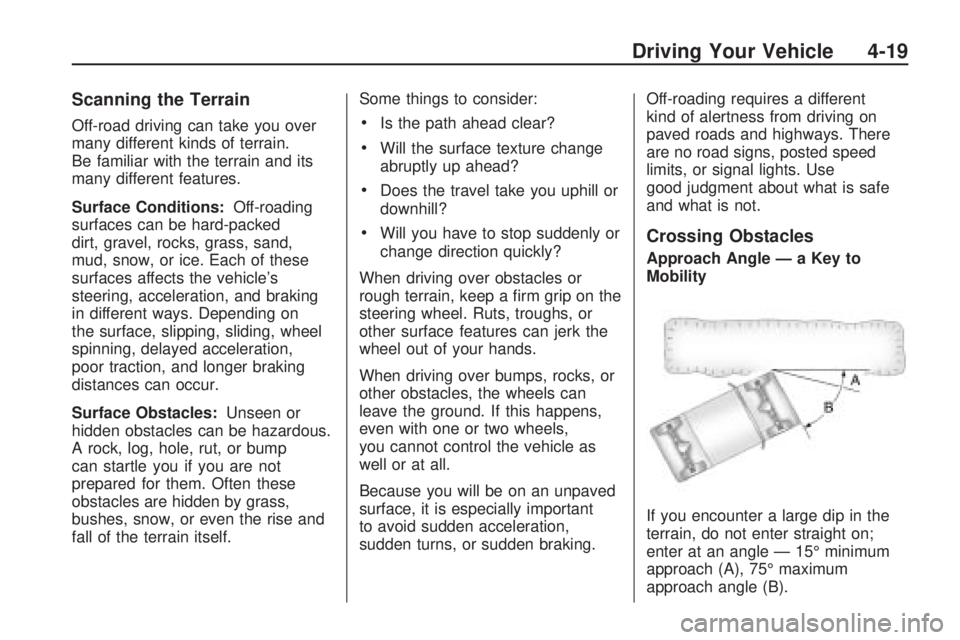
Scanning the Terrain
Off-road driving can take you over
many different kinds of terrain.
Be familiar with the terrain and its
many different features.
Surface Conditions:Off-roading
surfaces can be hard-packed
dirt, gravel, rocks, grass, sand,
mud, snow, or ice. Each of these
surfaces affects the vehicle’s
steering, acceleration, and braking
in different ways. Depending on
the surface, slipping, sliding, wheel
spinning, delayed acceleration,
poor traction, and longer braking
distances can occur.
Surface Obstacles:Unseen or
hidden obstacles can be hazardous.
A rock, log, hole, rut, or bump
can startle you if you are not
prepared for them. Often these
obstacles are hidden by grass,
bushes, snow, or even the rise and
fall of the terrain itself.Some things to consider:Is the path ahead clear?
Will the surface texture change
abruptly up ahead?
Does the travel take you uphill or
downhill?
Will you have to stop suddenly or
change direction quickly?
When driving over obstacles or
rough terrain, keep a �rm grip on the
steering wheel. Ruts, troughs, or
other surface features can jerk the
wheel out of your hands.
When driving over bumps, rocks, or
other obstacles, the wheels can
leave the ground. If this happens,
even with one or two wheels,
you cannot control the vehicle as
well or at all.
Because you will be on an unpaved
surface, it is especially important
to avoid sudden acceleration,
sudden turns, or sudden braking.Off-roading requires a different
kind of alertness from driving on
paved roads and highways. There
are no road signs, posted speed
limits, or signal lights. Use
good judgment about what is safe
and what is not.Crossing Obstacles
Approach Angle — a Key to
Mobility
If you encounter a large dip in the
terrain, do not enter straight on;
enter at an angle — 15° minimum
approach (A), 75° maximum
approach angle (B).
Driving Your Vehicle 4-19
Page 203 of 382
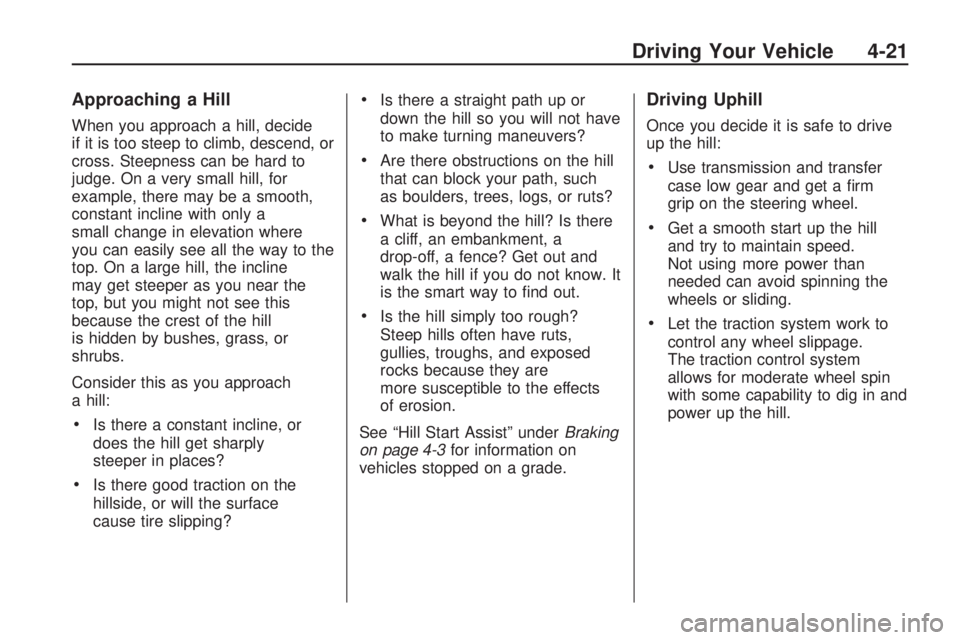
Approaching a Hill
When you approach a hill, decide
if it is too steep to climb, descend, or
cross. Steepness can be hard to
judge. On a very small hill, for
example, there may be a smooth,
constant incline with only a
small change in elevation where
you can easily see all the way to the
top. On a large hill, the incline
may get steeper as you near the
top, but you might not see this
because the crest of the hill
is hidden by bushes, grass, or
shrubs.
Consider this as you approach
a hill:
Is there a constant incline, or
does the hill get sharply
steeper in places?
Is there good traction on the
hillside, or will the surface
cause tire slipping?
Is there a straight path up or
down the hill so you will not have
to make turning maneuvers?
Are there obstructions on the hill
that can block your path, such
as boulders, trees, logs, or ruts?
What is beyond the hill? Is there
a cliff, an embankment, a
drop-off, a fence? Get out and
walk the hill if you do not know. It
is the smart way to �nd out.
Is the hill simply too rough?
Steep hills often have ruts,
gullies, troughs, and exposed
rocks because they are
more susceptible to the effects
of erosion.
See “Hill Start Assist” underBraking
on page 4-3for information on
vehicles stopped on a grade.
Driving Uphill
Once you decide it is safe to drive
up the hill:
Use transmission and transfer
case low gear and get a �rm
grip on the steering wheel.
Get a smooth start up the hill
and try to maintain speed.
Not using more power than
needed can avoid spinning the
wheels or sliding.
Let the traction system work to
control any wheel slippage.
The traction control system
allows for moderate wheel spin
with some capability to dig in and
power up the hill.
Driving Your Vehicle 4-21
Page 204 of 382
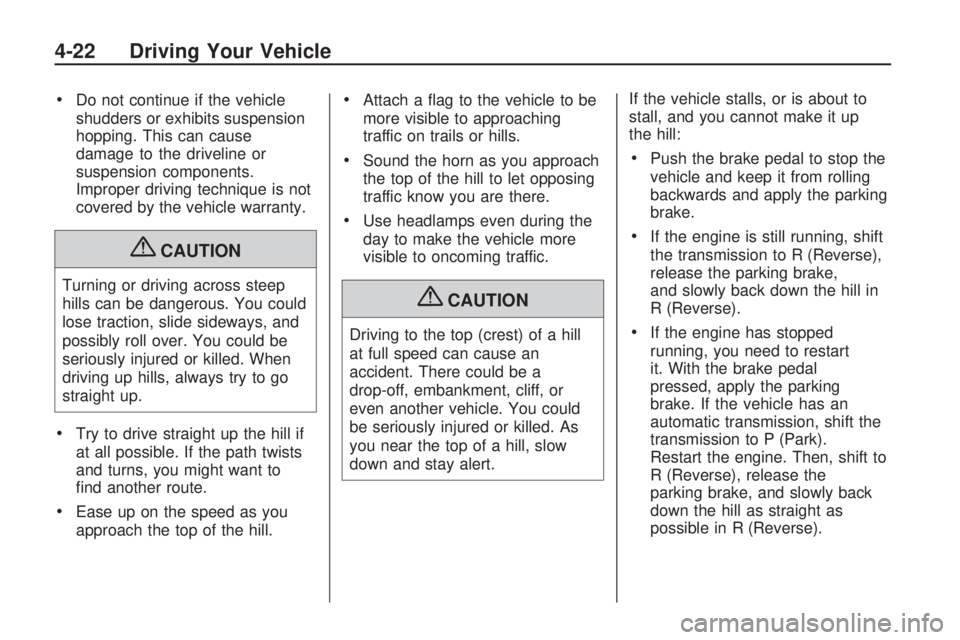
Do not continue if the vehicle
shudders or exhibits suspension
hopping. This can cause
damage to the driveline or
suspension components.
Improper driving technique is not
covered by the vehicle warranty.
{CAUTION
Turning or driving across steep
hills can be dangerous. You could
lose traction, slide sideways, and
possibly roll over. You could be
seriously injured or killed. When
driving up hills, always try to go
straight up.
Try to drive straight up the hill if
at all possible. If the path twists
and turns, you might want to
�nd another route.
Ease up on the speed as you
approach the top of the hill.
Attach a �ag to the vehicle to be
more visible to approaching
traffic on trails or hills.
Sound the horn as you approach
the top of the hill to let opposing
traffic know you are there.
Use headlamps even during the
day to make the vehicle more
visible to oncoming traffic.
{CAUTION
Driving to the top (crest) of a hill
at full speed can cause an
accident. There could be a
drop-off, embankment, cliff, or
even another vehicle. You could
be seriously injured or killed. As
you near the top of a hill, slow
down and stay alert.If the vehicle stalls, or is about to
stall, and you cannot make it up
the hill:
Push the brake pedal to stop the
vehicle and keep it from rolling
backwards and apply the parking
brake.
If the engine is still running, shift
the transmission to R (Reverse),
release the parking brake,
and slowly back down the hill in
R (Reverse).
If the engine has stopped
running, you need to restart
it. With the brake pedal
pressed, apply the parking
brake. If the vehicle has an
automatic transmission, shift the
transmission to P (Park).
Restart the engine. Then, shift to
R (Reverse), release the
parking brake, and slowly back
down the hill as straight as
possible in R (Reverse).
4-22 Driving Your Vehicle
Page 206 of 382
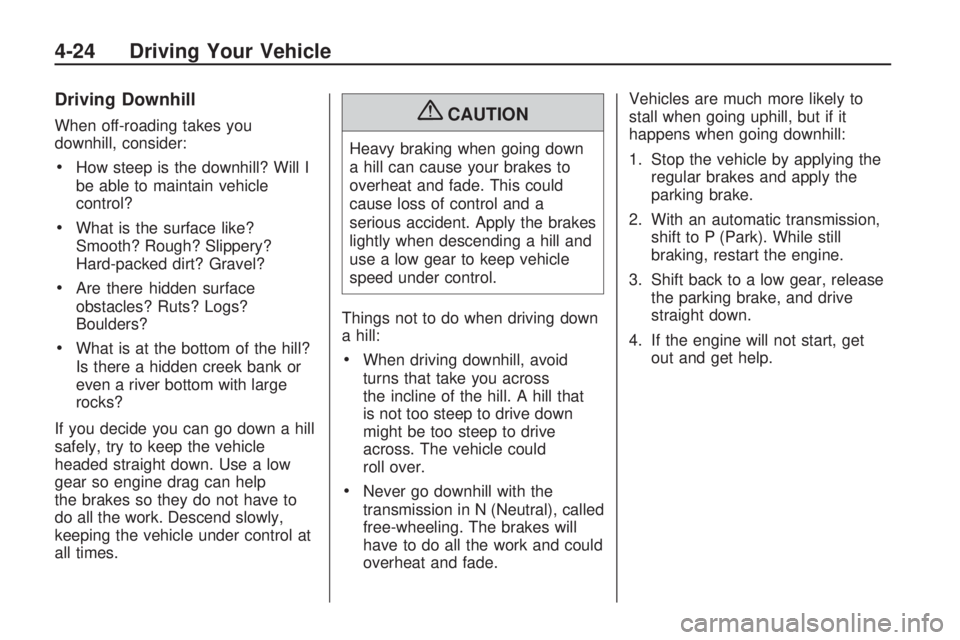
Driving Downhill
When off-roading takes you
downhill, consider:
How steep is the downhill? Will I
be able to maintain vehicle
control?
What is the surface like?
Smooth? Rough? Slippery?
Hard-packed dirt? Gravel?
Are there hidden surface
obstacles? Ruts? Logs?
Boulders?
What is at the bottom of the hill?
Is there a hidden creek bank or
even a river bottom with large
rocks?
If you decide you can go down a hill
safely, try to keep the vehicle
headed straight down. Use a low
gear so engine drag can help
the brakes so they do not have to
do all the work. Descend slowly,
keeping the vehicle under control at
all times.
{CAUTION
Heavy braking when going down
a hill can cause your brakes to
overheat and fade. This could
cause loss of control and a
serious accident. Apply the brakes
lightly when descending a hill and
use a low gear to keep vehicle
speed under control.
Things not to do when driving down
a hill:
When driving downhill, avoid
turns that take you across
the incline of the hill. A hill that
is not too steep to drive down
might be too steep to drive
across. The vehicle could
roll over.
Never go downhill with the
transmission in N (Neutral), called
free-wheeling. The brakes will
have to do all the work and could
overheat and fade.Vehicles are much more likely to
stall when going uphill, but if it
happens when going downhill:
1. Stop the vehicle by applying the
regular brakes and apply the
parking brake.
2. With an automatic transmission,
shift to P (Park). While still
braking, restart the engine.
3. Shift back to a low gear, release
the parking brake, and drive
straight down.
4. If the engine will not start, get
out and get help.
4-24 Driving Your Vehicle
Page 208 of 382
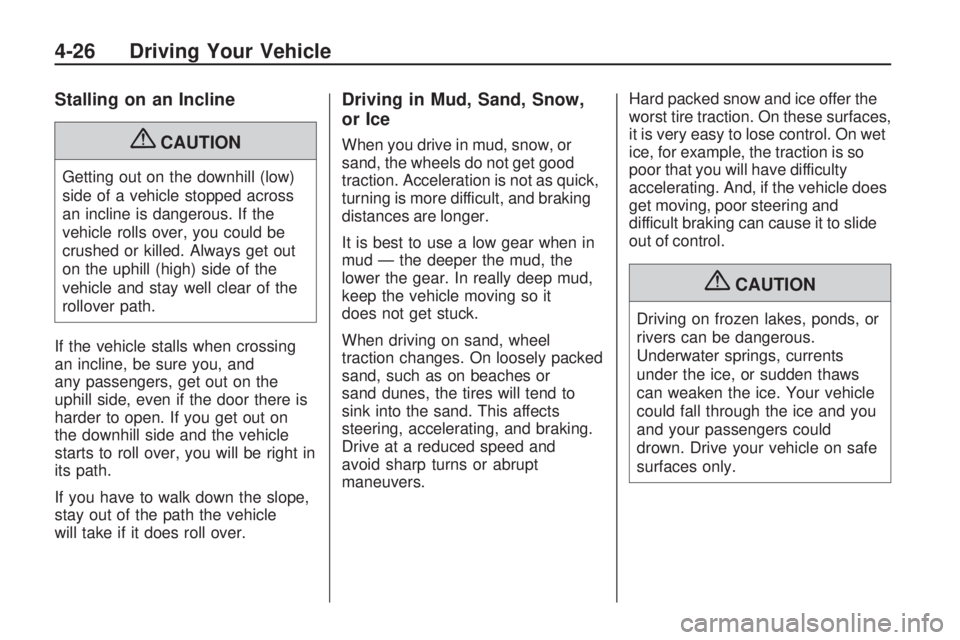
Stalling on an Incline
{CAUTION
Getting out on the downhill (low)
side of a vehicle stopped across
an incline is dangerous. If the
vehicle rolls over, you could be
crushed or killed. Always get out
on the uphill (high) side of the
vehicle and stay well clear of the
rollover path.
If the vehicle stalls when crossing
an incline, be sure you, and
any passengers, get out on the
uphill side, even if the door there is
harder to open. If you get out on
the downhill side and the vehicle
starts to roll over, you will be right in
its path.
If you have to walk down the slope,
stay out of the path the vehicle
will take if it does roll over.
Driving in Mud, Sand, Snow,
or Ice
When you drive in mud, snow, or
sand, the wheels do not get good
traction. Acceleration is not as quick,
turning is more difficult, and braking
distances are longer.
It is best to use a low gear when in
mud — the deeper the mud, the
lower the gear. In really deep mud,
keep the vehicle moving so it
does not get stuck.
When driving on sand, wheel
traction changes. On loosely packed
sand, such as on beaches or
sand dunes, the tires will tend to
sink into the sand. This affects
steering, accelerating, and braking.
Drive at a reduced speed and
avoid sharp turns or abrupt
maneuvers.Hard packed snow and ice offer the
worst tire traction. On these surfaces,
it is very easy to lose control. On wet
ice, for example, the traction is so
poor that you will have difficulty
accelerating. And, if the vehicle does
get moving, poor steering and
difficult braking can cause it to slide
out of control.
{CAUTION
Driving on frozen lakes, ponds, or
rivers can be dangerous.
Underwater springs, currents
under the ice, or sudden thaws
can weaken the ice. Your vehicle
could fall through the ice and you
and your passengers could
drown. Drive your vehicle on safe
surfaces only.
4-26 Driving Your Vehicle
Page 209 of 382
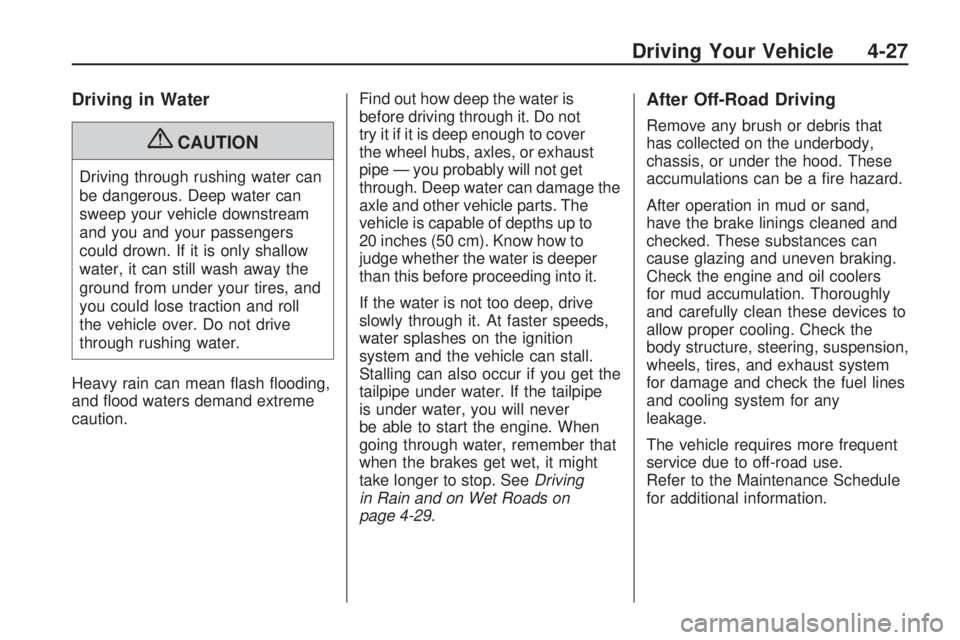
Driving in Water
{CAUTION
Driving through rushing water can
be dangerous. Deep water can
sweep your vehicle downstream
and you and your passengers
could drown. If it is only shallow
water, it can still wash away the
ground from under your tires, and
you could lose traction and roll
the vehicle over. Do not drive
through rushing water.
Heavy rain can mean �ash �ooding,
and �ood waters demand extreme
caution.Find out how deep the water is
before driving through it. Do not
try it if it is deep enough to cover
the wheel hubs, axles, or exhaust
pipe — you probably will not get
through. Deep water can damage the
axle and other vehicle parts. The
vehicle is capable of depths up to
20 inches (50 cm). Know how to
judge whether the water is deeper
than this before proceeding into it.
If the water is not too deep, drive
slowly through it. At faster speeds,
water splashes on the ignition
system and the vehicle can stall.
Stalling can also occur if you get the
tailpipe under water. If the tailpipe
is under water, you will never
be able to start the engine. When
going through water, remember that
when the brakes get wet, it might
take longer to stop. SeeDriving
in Rain and on Wet Roads on
page 4-29.
After Off-Road Driving
Remove any brush or debris that
has collected on the underbody,
chassis, or under the hood. These
accumulations can be a �re hazard.
After operation in mud or sand,
have the brake linings cleaned and
checked. These substances can
cause glazing and uneven braking.
Check the engine and oil coolers
for mud accumulation. Thoroughly
and carefully clean these devices to
allow proper cooling. Check the
body structure, steering, suspension,
wheels, tires, and exhaust system
for damage and check the fuel lines
and cooling system for any
leakage.
The vehicle requires more frequent
service due to off-road use.
Refer to the Maintenance Schedule
for additional information.
Driving Your Vehicle 4-27
Page 225 of 382
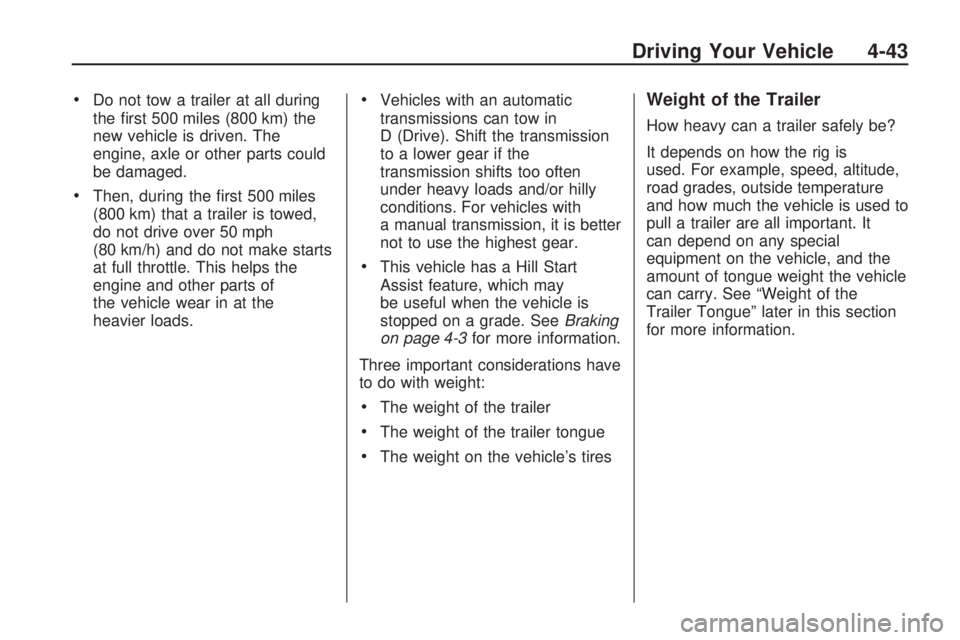
Do not tow a trailer at all during
the �rst 500 miles (800 km) the
new vehicle is driven. The
engine, axle or other parts could
be damaged.
Then, during the �rst 500 miles
(800 km) that a trailer is towed,
do not drive over 50 mph
(80 km/h) and do not make starts
at full throttle. This helps the
engine and other parts of
the vehicle wear in at the
heavier loads.
Vehicles with an automatic
transmissions can tow in
D (Drive). Shift the transmission
to a lower gear if the
transmission shifts too often
under heavy loads and/or hilly
conditions. For vehicles with
a manual transmission, it is better
not to use the highest gear.
This vehicle has a Hill Start
Assist feature, which may
be useful when the vehicle is
stopped on a grade. SeeBraking
on page 4-3for more information.
Three important considerations have
to do with weight:
The weight of the trailer
The weight of the trailer tongue
The weight on the vehicle’s tires
Weight of the Trailer
How heavy can a trailer safely be?
It depends on how the rig is
used. For example, speed, altitude,
road grades, outside temperature
and how much the vehicle is used to
pull a trailer are all important. It
can depend on any special
equipment on the vehicle, and the
amount of tongue weight the vehicle
can carry. See “Weight of the
Trailer Tongue” later in this section
for more information.
Driving Your Vehicle 4-43
Page 231 of 382
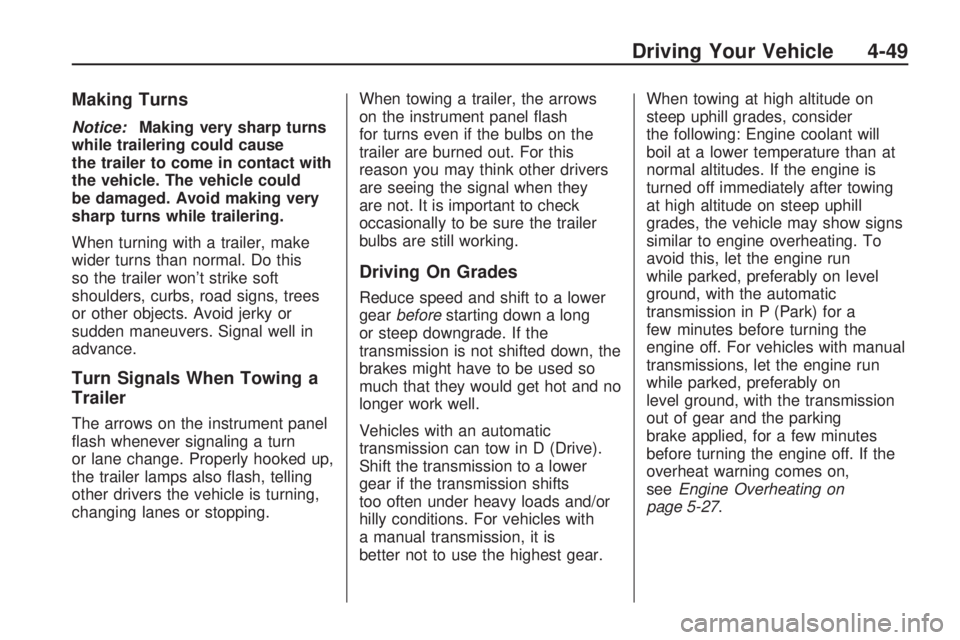
Making Turns
Notice:Making very sharp turns
while trailering could cause
the trailer to come in contact with
the vehicle. The vehicle could
be damaged. Avoid making very
sharp turns while trailering.
When turning with a trailer, make
wider turns than normal. Do this
so the trailer won’t strike soft
shoulders, curbs, road signs, trees
or other objects. Avoid jerky or
sudden maneuvers. Signal well in
advance.
Turn Signals When Towing a
Trailer
The arrows on the instrument panel
�ash whenever signaling a turn
or lane change. Properly hooked up,
the trailer lamps also �ash, telling
other drivers the vehicle is turning,
changing lanes or stopping.When towing a trailer, the arrows
on the instrument panel �ash
for turns even if the bulbs on the
trailer are burned out. For this
reason you may think other drivers
are seeing the signal when they
are not. It is important to check
occasionally to be sure the trailer
bulbs are still working.
Driving On Grades
Reduce speed and shift to a lower
gearbeforestarting down a long
or steep downgrade. If the
transmission is not shifted down, the
brakes might have to be used so
much that they would get hot and no
longer work well.
Vehicles with an automatic
transmission can tow in D (Drive).
Shift the transmission to a lower
gear if the transmission shifts
too often under heavy loads and/or
hilly conditions. For vehicles with
a manual transmission, it is
better not to use the highest gear.When towing at high altitude on
steep uphill grades, consider
the following: Engine coolant will
boil at a lower temperature than at
normal altitudes. If the engine is
turned off immediately after towing
at high altitude on steep uphill
grades, the vehicle may show signs
similar to engine overheating. To
avoid this, let the engine run
while parked, preferably on level
ground, with the automatic
transmission in P (Park) for a
few minutes before turning the
engine off. For vehicles with manual
transmissions, let the engine run
while parked, preferably on
level ground, with the transmission
out of gear and the parking
brake applied, for a few minutes
before turning the engine off. If the
overheat warning comes on,
seeEngine Overheating on
page 5-27.
Driving Your Vehicle 4-49